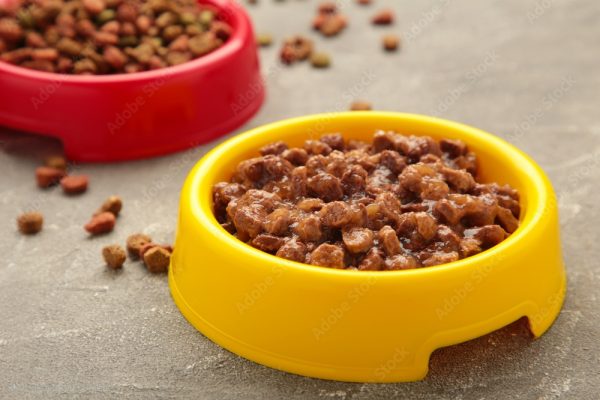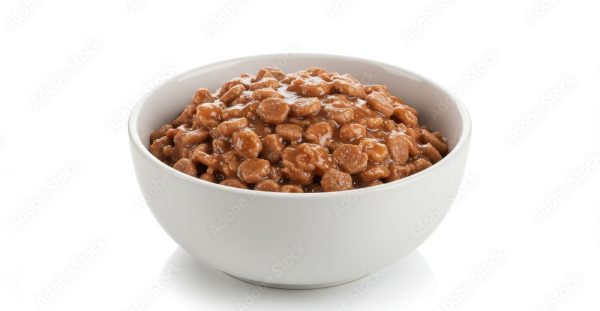When your dog has a sensitive stomach, even small dietary mistakes can lead to discomfort—vomiting, loose stools, excessive gas, or a complete lack of appetite.
As a veterinarian with over 15 years of experience, I’ve guided countless pet parents through choosing the right diet, and in many cases, high-quality wet dog food has been a true lifesaver for sensitive tummies.
Wet food is softer, easier to digest, and often more appealing to dogs who turn up their noses at kibble. However, not all wet dog foods are created equal. In this guide, I’ll share the top 5 vet-recommended wet dog foods especially for sensitive stomachs, explain why wet food often works better, and what key ingredients you should be looking for to ease your dog’s digestive troubles.

1. Why Wet Food is Better for Dogs with Sensitive Stomachs
Switching to wet food can significantly improve a dog’s digestion and overall comfort when they are struggling with stomach issues.
Here’s why wet food holds specific advantages:
Higher Moisture Content
Wet food typically contains 70–80% water, compared to just 10–12% in dry kibble.
This helps:
- Keep your dog hydrated
- Soften stools for easier passing
- Reduce the risk of constipation
- Support kidney health, especially in senior dogs
Softer Texture
The softer consistency of wet food:
- Requires less chewing effort
- Is easier to digest because it breaks down faster in the stomach
- Greatly benefits elderly dogs with dental problems or younger dogs recovering from illnesses
Limited Ingredients
Many premium wet foods are formulated with fewer ingredients, focusing on high-quality proteins and easily digestible carbohydrates.
This reduces the chances of triggering food sensitivities and improves digestive health.
Stronger Aroma and Taste
The stronger smell and richer flavor of wet food stimulate appetite, especially:
- Dogs recovering from illness
- Dogs who have become picky eaters
- Dogs with nausea-related issues
Reduced Bloating
Unlike some dry kibbles that swell after being eaten, wet foods do not expand in the stomach, helping to avoid gas build-up and bloating—a major advantage for breeds like Bulldogs, Boxers, and Yorkies prone to digestive discomfort.
2. Key Ingredients to Look For in Wet Food for Sensitive Stomachs
When selecting the right wet food, you’ll want to analyze the label carefully. Here’s what to prioritize:
Easily Digestible Proteins
Choose options with high-quality proteins like turkey, lamb, chicken, or salmon as the first ingredient.
These are easier on the stomach compared to beef or pork and support strong muscles without causing irritation.
Low-Fat Formulas
High-fat foods can slow digestion and worsen diarrhea or vomiting.
For sensitive stomachs, low to moderate fat content is ideal.
Prebiotics and Fiber
Ingredients like chicory root, pumpkin, or inulin provide natural prebiotic fiber to nourish good gut bacteria and maintain healthy digestion.
No Artificial Additives
Avoid foods containing:
- Artificial preservatives (BHA, BHT)
- Artificial colors and flavors
- Soy, wheat gluten, or by-products
Artificial additives are common culprits behind food intolerances and allergic reactions.
Grain-Free or Limited-Grain Formulas
While not every dog needs a grain-free diet, those with sensitive stomachs often benefit from limited-grain or grain-free options that avoid common irritants like corn and wheat.
Summary Tip:
Simple, natural, and digestible are the three magic words you should think about when scanning ingredient labels.
3. Top 5 Vet-Recommended Wet Dog Foods for Sensitive Stomachs (2025)
After evaluating digestibility, ingredient quality, veterinary feedback, and real-world results, here are my top 5 picks for 2025:
| Brand | Key Protein | Grain-Free | Vet Notes | Price (USD) |
| Hill’s Science Diet Sensitive Stomach & Skin | Chicken | No | Balanced for sensitive GI & skin health, highly digestible and backed by clinical studies | $35 (12 cans) |
| Purina Pro Plan Sensitive Skin & Stomach | Salmon | Yes | Includes prebiotic fiber and highly digestible proteins; vet-trusted for mild sensitivities | $38 (12 cans) |
| Royal Canin Veterinary Gastrointestinal Low Fat | Pork/Liver | No | Prescription-grade option for severe GI conditions; very easy on digestion | $42 (12 cans) |
| Blue Buffalo Basics Limited Ingredient | Turkey | Yes | One protein + one carb source; great for food allergies and mild stomach upset | $40 (12 cans) |
| Wellness Simple Limited Ingredient Wet Food | Duck | Yes | Single-source protein, grain-free, highly digestible, no artificial additives | $39 (12 cans) |
Why These Brands Made the List:
- Hill’s Science Diet: Extensive clinical research backs its effectiveness for both GI and skin sensitivities.
- Purina Pro Plan: Trusted by veterinarians, it offers a balanced formula with natural prebiotics for digestive health.
- Royal Canin Veterinary Gastrointestinal: Especially for dogs with severe digestive issues like pancreatitis or IBD.
- Blue Buffalo Basics: Focuses on minimal ingredients to eliminate most allergens.
- Wellness Simple: One of the best for eliminating additives and offering a super gentle, palatable formula.
✅ Pro Tip:
All these options are designed not only to soothe the digestive tract but also to reduce the chance of triggering allergies or causing nutrient imbalances.
4. Signs Your Dog Might Need Sensitive-Stomach Food
Not sure if your dog needs a sensitive-stomach formula?
Here are some common warning signs that their current diet might be causing digestive distress:
- Chronic or Recurring Diarrhea: Occasional loose stools happen, but frequent diarrhea suggests a deeper issue.
- Frequent Vomiting: If vomiting is happening regularly without another obvious cause like illness or toxin ingestion, food could be the culprit.
- Loud Gurgling Sounds in the Stomach: Excessive gut noises (borborygmi) can indicate digestion problems, gas buildup, or food sensitivities.
- Loss of Appetite or Picky Eating: Dogs avoiding their meals may be experiencing subtle stomach discomfort.
- Constant Paw Licking or Chewing: Gastrointestinal upset and food allergies often manifest as skin irritations.
- Itchy or Flaky Skin: Poor digestion can also affect skin health, leading to dryness, rashes, or chronic itching.
✅ Summary:
If your dog displays two or more of these symptoms consistently, it’s time to switch to a sensitive-stomach wet food formula and observe their improvement over 2–3 weeks. Always consult your vet for personalized guidance.
5. Transitioning to Wet Food: Do It Gently
Transitioning a dog with a sensitive stomach to wet food requires patience and care.
Switching too abruptly—even to a better food—can cause additional stomach upset.
Why a Slow Transition Is Crucial:
- Your dog’s gut microbiota (the good bacteria in their intestines) needs time to adjust to new ingredients.
- Abrupt changes can shock the digestive system, causing diarrhea, vomiting, bloating, and discomfort.
- Gradual transition minimizes the risk of rejection or food aversion.
Recommended Transition Schedule:
| Days | Old Food | New Food |
| Days 1–2 | 75% old food | 25% new food |
| Days 3–4 | 50% old food | 50% new food |
| Days 5–6 | 25% old food | 5% new food |
| Day 7+ | 100% new food |
Helpful Tip:
- If your dog shows mild loose stools during the transition, pause at the current ratio for an extra day or two before increasing the new food.
- Adding a little warm water can make wet food even more digestible and enticing during the switch.
Downsides of Rushing the Transition:
- Severe diarrhea leading to dehydration
- Temporary loss of appetite
- Increased gas and bloating
- Development of picky eating habits
Bottom Line:
A slow, careful transition ensures your dog’s body accepts the new diet smoothly and healthily.
Take it one step at a time—this isn’t a race. Gradual changes allow your dog’s gut bacteria to adapt and build tolerance.
If your pet resists the new food, try warming it slightly or mixing it with a bit of the old food to encourage acceptance. Be observant: monitor stool consistency, appetite, and energy levels throughout the transition. Remember, consistency and patience can make all the difference in achieving long-term digestive comfort.
6. Wet Food vs. Dry Food for Digestive Health
If you’re wondering whether wet food truly is superior for sensitive stomachs compared to dry kibble, here’s a quick comparison:
| Aspect | Wet Food | Dry Food |
| Moisture Content | 70–80% | 10–12% |
| Palatability | Stronger aroma and taste | Mild aroma, less flavor-rich |
| Digestibility | Generally easier on sensitive stomachs | May cause bloating or firmer stools |
| Storage | Requires refrigeration after opening | Shelf-stable and easy to store |
| Cost | More expensive per meal | More affordable per pound |
Key Summary:
- Wet food is gentler, more hydrating, and easier to digest—making it ideal for dogs with existing digestive problems, older pets, and picky eaters.
- Dry food offers better storage convenience and is usually more budget-friendly but can sometimes be harder on a sensitive gut.
Many pet parents find a mixed feeding approach (wet + dry) strikes the perfect balance for cost, dental health, and digestion.
7. Cost Comparison: Wet Food for Sensitive Stomachs (2025 Edition)
Feeding wet food exclusively can get costly, especially for medium to large dogs. Here’s a realistic cost breakdown based on 2025 pricing:
| Brand | Per Can (USD) | Daily Amount for Medium Dog (Approx.) | Estimated Monthly Cost |
| Hill’s Science Diet Sensitive Stomach & Skin | $2.90 | 1.5 cans/day | $130–$140 |
| Purina Pro Plan Sensitive Stomach | $3.10 | 1.5 cans/day | $135–$145 |
| Royal Canin Veterinary Gastrointestinal | $3.50 | 1–2 cans/day | $140–$160 |
| Blue Buffalo Basics Limited Ingredient | $3.30 | 1.5 cans/day | $135–$150 |
| Wellness Simple Limited Ingredient | $3.25 | 1.5 cans/day | $130–$145 |
Cost-Saving Tip:
- Many owners use wet food as a topper—mixing ¼ to ½ can of wet food into a high-quality dry kibble base.
- This way, you get the digestive benefits of wet food without doubling monthly food costs.
Summary of Findings:
Among the top 5, Hill’s Science Diet and Purina Pro Plan offer the most cost-effective options, staying just below the $145 monthly mark for medium-sized dogs. Royal Canin, being prescription-grade, ranks as the most expensive—best suited for dogs with serious digestive disorders. Wellness Simple and Blue Buffalo fall into the mid-tier range, offering good value for money with balanced formulations and premium ingredients.
Mixing wet food with kibble remains a budget-friendly strategy for those looking to optimize cost and digestive health.
Conclusion
Choosing the right wet food for a dog with a sensitive stomach can significantly improve their quality of life. From soothing digestive issues to enhancing appetite and hydration, the benefits of switching to a vet-recommended wet food are clear.
By understanding what to look for—easily digestible proteins, limited ingredients, and the absence of artificial additives—you can make informed choices that support your dog’s health. Remember, the transition should be slow and steady, and cost can be managed by combining wet food with high-quality dry kibble.
Ultimately, the right food can lead to fewer vet visits, happier mealtimes, and a healthier, more energetic pet.



